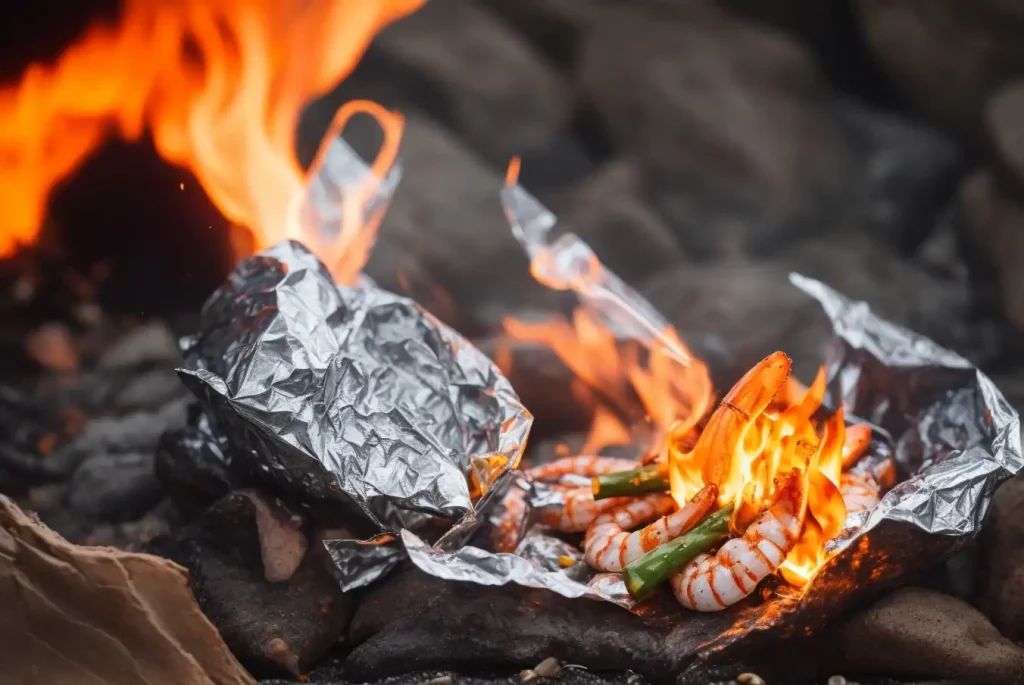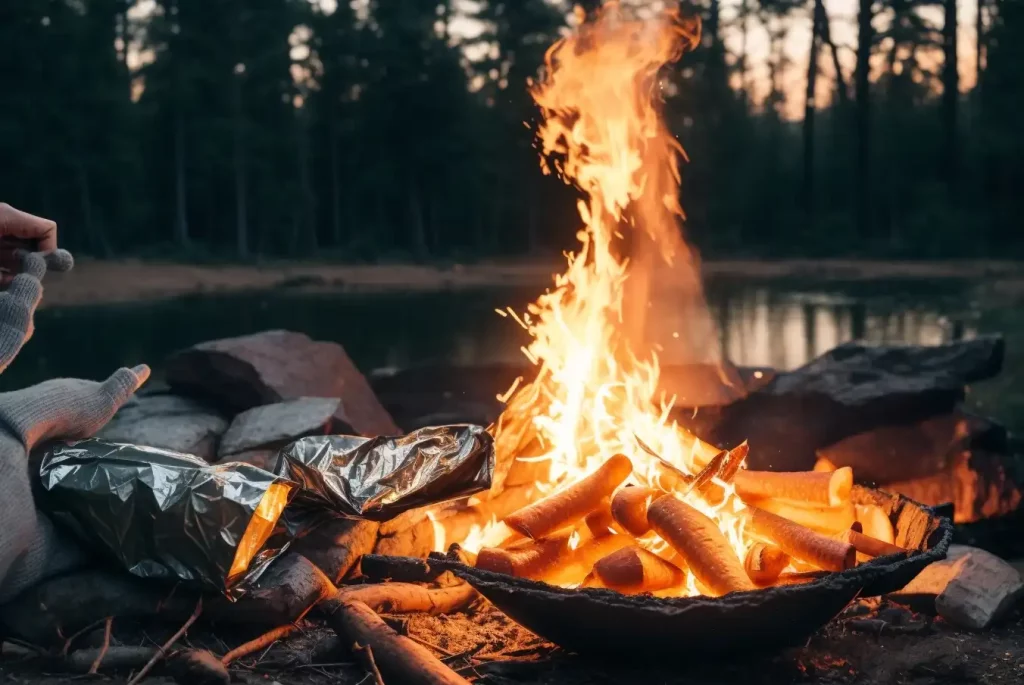Hey there, outdoor enthusiasts! Welcome back to TheOutdoorInsider.com! Today, we’re diving deep into the art of Campfire Foil Packet Cooking.
If you’re anything like me, you cherish the experience of cooking over an open flame.
But let’s face it, nobody likes the cleanup after, right?
Well, that’s exactly where foil packet cooking comes to the rescue.
Trust me, by the end of this article, you’ll be a foil packet chef.
Ready to explore? Let’s get cooking!
Why Choose Foil Packet Cooking for Campfires?
Foil packet cooking is more than just a fad; it’s an outdoor culinary revolution that’s taking over campsites. Here’s why it’s winning hearts and stomachs.
Easy and Convenient
The simplicity of foil packet cooking is what really makes it a winner in my books. Remember my last camping trip? Well, I was with a bunch of friends and we were dreading the dishwashing part after cooking. That’s when we decided to give foil packet cooking a try.
You just need a square of aluminum foil, your choice of ingredients, and voila! Wrap ’em up, toss them on the fire, and forget about it. The foil acts as a makeshift pan, trapping in heat and cooking your food evenly. Plus, when you’re done eating, you just recycle the foil. No pots, no pans, no problem!
Versatile Menu Options
When I say you can cook anything in a foil packet, I mean anything.
From veggies and shrimp to chicken and even dessert.
Last summer, we tried foil packet fajitas, and let me tell you, they were a hit!
You can literally throw in whatever you have—meat, veggies, seasonings—and create something delicious.
But don’t stop there. Have you ever tried foil packet brownies? Yup, that’s right—brownies! Just prepare your brownie mix as you normally would at home, pour it into a foil packet, and let it cook. You’ll have gooey, melt-in-your-mouth brownies that’ll make you the star of the camping trip.
Eco-Friendly
While we’re all here to enjoy Mother Nature, it’s crucial that we also respect her.
I know, I know, using aluminum foil might not seem like the most eco-friendly choice at first glance.
But guess what? Aluminum foil is recyclable. If you’re responsible and recycle your used foil, you’re essentially giving it a second life.
So, not only do you avoid washing dishes and wasting water, but you’re also contributing to a sustainable camping experience.
Using a dedicated campfire cooking kit can also minimize waste, as you’re reusing tools specifically designed for outdoor cooking, which is a bonus for eco-conscious adventurers.

Essential Ingredients and Tools
Alright, we’ve talked about why foil packet cooking is the way to go. Now, let’s get down to the nitty-gritty: what you’ll actually need to make your culinary masterpiece.
Basic Ingredients
The beauty of foil packet cooking lies in its versatility. You can get as simple or as fancy as you like. Here’s a basic rundown of ingredients you might want to consider:
- Vegetables: Potatoes, carrots, bell peppers, onions—basically anything that can withstand high heat.
- Proteins: Chicken, fish, shrimp, or even tofu for our plant-based buddies.
- Spices: Salt, pepper, garlic powder, or paprika. Mix and match to fit your taste buds!
- Herbs: Fresh or dried—think basil, thyme, or rosemary.
- Sauces or Marinades: BBQ sauce, lemon juice, or even a splash of wine. Get creative!
Feel free to mix and match. For instance, I once tried mixing shrimp with asparagus, olive oil, and a sprinkle of Cajun seasoning—man, was that a hit!
Necessary Cooking Tools
When it comes to tools, there isn’t much you need, but one thing you absolutely cannot skimp on is heavy-duty aluminum foil.
The last thing you want is for your foil to rip and spill all those precious ingredients into the campfire. A good tip? Double wrap your food for extra security.
Don’t forget a pair of tongs or oven mitts to handle the packets on the fire safely.
Also learn: Foil-Wrapped Cakes and Muffins, Foil Packet Veggies
How to Prepare a Foil Packet
Ready to roll up your sleeves and get cooking? Let’s dive into how to actually prepare these foil packets.
Choosing Your Ingredients
First things first: picking the right ingredients is key. Fresh is best, but if you’re going on a longer trip, consider vegetables that have a longer shelf life, like potatoes or bell peppers.
If you’re using meat, opt for cuts that cook quickly, like chicken tenders or fish fillets.
Oh, and marinading beforehand? That’s your golden ticket to Flavor Town.
Assembly Instructions
Now that you’ve got your ingredients sorted, here’s a simple guide on how to assemble a foil packet:
- Cut the Foil: Cut a large square of heavy-duty aluminum foil, roughly 12×12 inches.
- Prep the Ingredients: Slice your veggies and proteins into similar sizes for even cooking.
- Arrange: Place your ingredients in the center of the foil square.
- Season: Sprinkle your choice of spices, herbs, and sauces.
- Seal it Up: Fold the foil over the ingredients and crimp the edges tightly to seal the packet.
- Double Wrap: For added security and to avoid spillage, wrap it in a second layer of foil.
- Label: If you’re making different packets, use a permanent marker to label the top, so you know what’s inside.
And there you have it! Your foil packet is ready for the campfire. All that’s left now is to cook it and dig in!
Cooking Techniques
So you’ve got your foil packets all ready to go—great! Now let’s talk about cooking techniques. Believe it or not, you’ve got some options even with something as straightforward as campfire cooking.
Direct Heat Method
Now, this method is as primal as it gets: cooking your foil packet directly on the campfire coals. Ah, feel that heat?
What works best here?
Meat and hearty vegetables like potatoes and carrots shine when cooked directly on the coals. They get to soak up that smoky aroma and cook evenly.
Ever tried a simple foil packet burger patty with sliced onions and BBQ sauce? Trust me, you’ll want to.
Grate Method
If you’re not too keen on tossing your food straight onto the coals, no worries! A campfire grate is your next best friend.
Position your grate over the fire and place your foil packets on top.
What should you cook this way?
This method is great for delicate proteins like fish or softer veggies like zucchini and asparagus that might get too mushy if cooked directly on the coals.
Grate cooking also allows for more control, so it’s easier to avoid overcooking. For example, a foil packet with tilapia, lemon slices, and dill is a hit when done over a grate.
Time and Temperature Guide
Alright, let’s demystify one of the trickiest parts of campfire foil packet cooking: How long do you actually cook these things? And at what heat?
Meat and Fish
Generally speaking, cooking times can vary depending on the heat of your fire and the thickness of your meat or fish.
- Chicken: Cook for 20-30 minutes, flipping halfway. You’ll know it’s done when it reaches an internal temperature of 165°F (74°C).
- Fish: Usually takes around 10-15 minutes. Look for flaky texture and a slightly translucent color.
Just keep an eye on things, and if in doubt, a cooking thermometer is a great tool to pack.
Vegetables
Not all veggies are created equal, especially when it comes to cooking times.
- Potatoes: Expect to leave them on for about 20-30 minutes, depending on how small you’ve cut them.
- Softer Veggies: Think bell peppers or onions. These usually cook in about 10-15 minutes.
If you’re mixing vegetables in one packet, cut the harder veggies smaller than the softer ones to ensure they cook evenly.
The key takeaway here? Always check for doneness before devouring your campfire creation. You know, just to be on the safe side. Happy cooking, adventurers!
Safety Precautions
Hold up, adventurer! Before you dive into your foil-wrapped culinary masterpiece, let’s talk safety. Because nothing ruins a good campout like a foodborne illness or a wildfire, am I right?
Food Safety
First off, we need to make sure the grub we’re cooking is as safe to eat as it is tasty.
- Storage: Always keep your meats and perishables in a cooler with ice. A simple rule: if it belongs in a fridge at home, it should be in a cooler at camp.
- Temperatures: Pack a food thermometer to ensure your meats are cooked through. Chicken should be at least 165°F (74°C), and fish should flake easily.
- Cross-Contamination: Keep raw and cooked foods separate. Bring extra utensils for handling raw meat and a different set for serving.
Campfire Safety
Now, onto the fire part of the campfire.
- Fire Ring/Pit: Always use a designated fire ring or pit, away from trees and flammable items.
- Attend to Your Fire: Never leave your fire unattended. I mean, ever!
- Putting Out the Fire: Thoroughly douse the fire with water when you’re done, ensuring it’s completely out. If it’s too hot to touch, it’s too hot to leave.
Troubleshooting Common Issues
So you’ve hit a snag or two? Happens to the best of us. Let’s troubleshoot.
- Uneven Cooking: Make sure you’re flipping your foil packets halfway through the cooking time. For a uniform cook, keep your ingredients uniformly sliced.
- Burning: If you’re getting charred food, you might be cooking too close to the coals. Lift the grate or lessen the cooking time.
- Packet Breakage: No one wants a foil tear spilling their dinner into the fire. Always use heavy-duty aluminum foil and double wrap it if needed.
FAQs about Campfire Foil Packet Cooking
Can you put foil packets directly in fire?
Yes, you can place foil packets directly on campfire coals, but make sure to use heavy-duty aluminum foil for best results.
How long do you leave foil packets on fire?
The cooking time varies, but generally, 20-30 minutes should suffice for most recipes.
Can you cook foil packets on a camp stove?
Absolutely, foil packets can be cooked on a camp stove, just adjust the heat to medium-high.
What temperature do you cook foil packets?
If you’re using a camp stove, aim for a medium-high heat setting, which is roughly around 375°F to 400°F.
Conclusion
Phew, that was a ride! Campfire foil packet cooking isn’t just about throwing some ingredients into aluminum foil and hoping for the best. It’s an art and a science, combining safety, technique, and a whole lot of flavor.
Whether you’re a meat lover, a veggie enthusiast, or somewhere in between, foil packet cooking has got you covered. It’s all the flavors of home, with the added spice of adventure. Happy camping and bon appétit!


